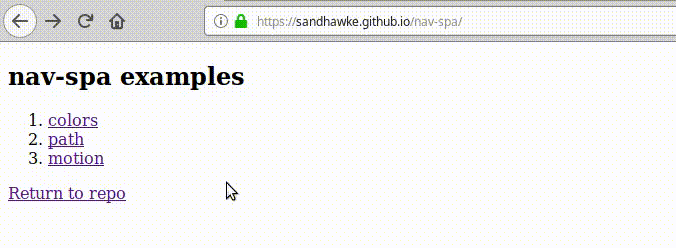nav-spa v1.0.1
nav-spa
This code makes URL navigation in your SPA look just like classic HATEOAS websites, where the URL tells people what's going on. Every state (if you want) can be bookmarked, shared, and even edited by hand in the address bar. We put things in the query string by default, but if you provide parse+unparse functions, state can also be encoded using the path and/or hash.
Alternatives include more established options like react-router-redux, or using architectures like service-workers to get SPA performance, without actually being a SPA. This seemed simpler to me.

There are currently some examples, running on github pages. The simplest ('colors') is something like:
const nav = require('nav-spa')
nav.on('change-color', ({key, oldValue, newValue}) => {
console.log('Nav-state property %o changed value from %o to %o',
key, oldValue, newValue)
if (!newValue) newValue = 'white'
document.getElementById('test').style.backgroundColor = newValue
document.title = `Hello in ${newValue}`
})The state-changing navigation in this case is set-up by HTML like this:
<a data-link-to-state="{color: 'green'}">green</a>
<a data-link-to-state="{color: 'yellow'}">yellow</a>This module looks for data-link-to-state attributes and adds the
right href to get us to that state. The state is a JS expression which
is eval'd to produce a state overlay object. And properties not
mentioned in the overlay remain unchanged; set them to null or '' to
remove them. They're always strings, so for our purposes '' === null
== undefined. (Actually, you can provide a non-string and we'll
JSON.stringify it for you, but it's always handed back to you as a
string.) If your expression evals to function, it's called, passing it
the current state, and letting it return the new state.
You can get that URL manually with nav.link(...) or go ahead and
jump there, perhaps in an onclick handler, with nav.jump(...). The
.jump function has an option to skip putting it in browser history.
The module also sets some CSS classes on the links, so you can show users which of the states they are currently in. It shouldn't matter how they got to that state.
The "motion" example shows you can even change the url state at the browser frame rate. Seems to work okay, about as fast as that animation done without this library (see cheating.html in the same directory to compare.). For that example, we don't put the state in the browser history. (Imagine clicking back through your history, one animation frame at a time!)
Custom Paths
By default we store all the state in query parameters. You can (and probable should) provide functions to map some state properties into the pathname (and/or hash).
If you store state in the pathname, your web server will have to serve up this SPA for all those URLs (but still let your CSS and JS files through). You also need to include a link.rel=start to the one that's the starting empty state.
Example "path" shows this in action, modifying "colors" by adding this code:
nav.customPath = { parse, unparse }
function parse (path) {
path = path.slice(1) // skip the leading slash
if (path === '') return { }
if (/^\w+$/.test(path)) return { color: path }
return 'NotFound'
}
function unparse (state) {
if (state.color) return '/' + state.color
return '/'
}Your parse function takes a path and returns an object like { prop: value, prop2: value2, ... } with whatever state it gleaned. It returns the magic string 'NotFound' if it can't deal with this. In practice that NotFound flag is used to limit what URLs we intercept clicks on.
Your unparse function takes a state object, like what parse produced, and returns string which encodes some or all of that state.
This module automatically detects when state is encoded in a string and then skips encoding it in the query parameters. (It does this by calling your parse function on the string to see what will be able to extracted. It gives errors on the console if it detects a situation where parse and unparse are not acting as inverse functions of each other.)
